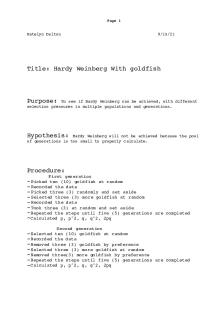Hardy Weinberg Problems T FB PDF

| Title | Hardy Weinberg Problems T FB |
|---|---|
| Author | Baraa Alyasin |
| Course | Biology for Science I |
| Institution | The University of Western Ontario |
| Pages | 3 |
| File Size | 115.3 KB |
| File Type | |
| Total Downloads | 57 |
| Total Views | 148 |
Summary
Download Hardy Weinberg Problems T FB PDF
Description
AP Biology
Mr. Brown
Hardy-Weinberg Problems Directions – On a separate piece of paper, solve the following problems using the Hardy-Weinberg equilibrium principle. Be certain to show all work and to explain all reasoning.
1. In guinea pigs, black coat color (B) is dominant to albino (b). In a population of guinea pigs, 16% are white. Determine the frequency of both alleles and each genotype in the population. 2. In cattle, black coat color is dominant to red coat. In a herd of 1000 cattle, 750 have black coats. Determine the frequency of both alleles and each genotype in the population. 3. If an isolated population has the following gene frequency: g = 0.8, what percent of the population will be homozygous dominant (GG), homozygous recessive (gg) and heterozygous (Gg)? 4. In Andalusian fowl, the gene for black plumage is incompletely dominant to the gene for white plumage. The resulting heterozygous individuals have slate blue plumage. In a flock of 1000 fowl, 90 have black plumage. Determine the frequency of each allele and each genotype in the population. 5. A population of 200 organisms consists of 100 members of each sex. Both sexes initially exhibit the same genotypic frequencies: 25% AA; 50% Aa; 25% aa. For some reason, males with the homozygous recessive genotype are incapable of mating. Determine the genotypic frequencies of all members of the next generation.
Hardy-Weinberg Problems Answers 1. In guinea pigs, black coat color (B) is dominant to albino (b). In a population of guinea pigs, 16% are white. Determine the frequency of both alleles and each genotype in the population. q2 = 0.16 [bb] q = 0.4 [b] p = 0.6 [B] p2 = 0.36 [BB] 2pq = 0.48 [Bb] 2. In cattle, black coat color is dominant to red coat. In a herd of 1000 cattle, 750 have black coats. Determine the frequency of both alleles and each genotype in the population. 250/1000 = 0.25 = q2
q = 0.5 [r] p2 = 0.25 [RR]
p = 0.5 [R] 2pq = 0.50 [Rr]
3. If an isolated population has the following gene frequency: g = 0.8, what percent of the population will be homozygous dominant (GG), homozygous recessive (gg) and heterozygous (Gg)? p = 0.2 [G] q2 = 0.64 [Gg]
q = 0.8 [g] 2pq = 0.32 [Gg]
p2 = 0.04 [GG]
4. In Andalusian fowl, the gene for black plumage is incompletely dominant to the gene for white plumage. The resulting heterozygous individuals have slate blue plumage. In a flock of 1000 fowl, 90 have black plumage. Determine the frequency of each allele and each genotype in the population. 90/1000 = 0.09 = p2 [BB]
p = 0.3 [B] q2 = 0.49 [Bb]
q = 0.7 [b] 2pq = 0.42 [Bb]
5. A population of 200 organisms consists of 100 members of each sex. Both sexes initially exhibit the same genotypic frequencies: 25% AA; 50% Aa; 25% aa. For some reason, males with the homozygous recessive genotype are incapable of mating. Determine the genotypic frequencies of all members of the next generation. Total = 200 organisms ♀:
25% AA 50% Aa 25% aa
Freq. = ♂:
25% AA 50% Aa Freq. =
50 A 0a 50 A 50 a 0 A 50 a 100 A 100 a 0.5 [A] 0.5 [a]
50 A 0a 50 A 50 a 100 A 50 a 0.67 [A]0.33 [a]
F2 generation: 1/2 A 1/2 a
2/3 A 2/3 AA 2/3 Aa
2/3 AA :
1/2 Aa :
1/3 a 1/6 Aa 1/6 aa
1/6 aa...
Similar Free PDFs

Hardy Weinberg Problems T FB
- 3 Pages

Hardy Weinberg problems
- 2 Pages

LP hardy weinberg
- 15 Pages

Koi Fish Hardy-Weinberg
- 8 Pages

Hardy Weinberg lab report
- 11 Pages

Genetika populasi hardy-weinberg
- 13 Pages

Hardy weinberg questions
- 3 Pages

Legge di Hardy-Weinberg
- 2 Pages

AP Bio Applying Hardy-Weinberg
- 4 Pages

Lab report of Hardy Weinberg
- 4 Pages

Hardy-weinberg Green Monkey Key
- 1 Pages

03-Lei de Hardy-Weinberg
- 9 Pages

Chapitre 1 Modèle de Hardy-Weinberg
- 11 Pages
Popular Institutions
- Tinajero National High School - Annex
- Politeknik Caltex Riau
- Yokohama City University
- SGT University
- University of Al-Qadisiyah
- Divine Word College of Vigan
- Techniek College Rotterdam
- Universidade de Santiago
- Universiti Teknologi MARA Cawangan Johor Kampus Pasir Gudang
- Poltekkes Kemenkes Yogyakarta
- Baguio City National High School
- Colegio san marcos
- preparatoria uno
- Centro de Bachillerato Tecnológico Industrial y de Servicios No. 107
- Dalian Maritime University
- Quang Trung Secondary School
- Colegio Tecnológico en Informática
- Corporación Regional de Educación Superior
- Grupo CEDVA
- Dar Al Uloom University
- Centro de Estudios Preuniversitarios de la Universidad Nacional de Ingeniería
- 上智大学
- Aakash International School, Nuna Majara
- San Felipe Neri Catholic School
- Kang Chiao International School - New Taipei City
- Misamis Occidental National High School
- Institución Educativa Escuela Normal Juan Ladrilleros
- Kolehiyo ng Pantukan
- Batanes State College
- Instituto Continental
- Sekolah Menengah Kejuruan Kesehatan Kaltara (Tarakan)
- Colegio de La Inmaculada Concepcion - Cebu


